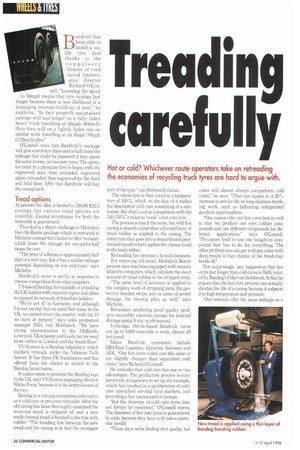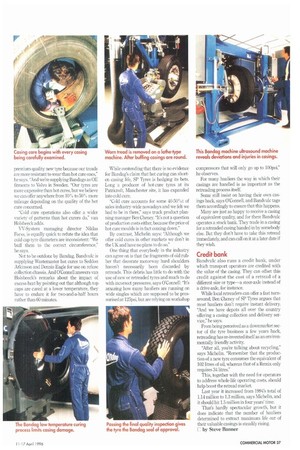Treadi carefu
Page 46

Page 47

If you've noticed an error in this article please click here to report it so we can fix it.
Bandvulc has been able to launch a sixlife tyre deal thanks to the compulsory fitment of road speed limiters, says director
Richard O'Connell. "Lowering the speed
to 56mph means that tyre casings last longer because there is less likelihood of a damaging internal build-up of heat," he explains. "In fact properly-maintained casings will last longer on a fully laden heavy truck travelling at 56mph (90km/h) than they will on a lightly laden one on similar work travelling at an illegal 70mph (1121u-n/h)-plus."
O'Connell says that Bandvulc's package will give customers three-and-a-half times the mileage that could be expected if they spent the same money on two new tyres. The operator must fit a premium tyre to begin with: it's regrooved once, then retreaded, regrooved again, retreaded, then regrooved for the third and final time. After that Bandvulc will buy the casing back.
Tread options
At present the offer is limited to 295/80 R22.5 casings, but various tread options are available. Casing acceptance for both the remoulds is guaranteed.
This deal is a direct challenge to Michelin's four-life Remix package which is restricted to Michelin casings but claims to offer two-anda-half times the mileage for one-and-a-half times the cost.
"The price of a Remix is approximately half that of a new tyre, but it has a similar mileage potential depending on size and type," says Michelin.
Bandvulc's move is partly in response to intense competition from other suppliers.
US-based Bandag, for example, is attacking the UK market with renewed vigour and plans to expand its network of franchise holders.
"We've got 47 in Germany, and although I'm not saying that we need that many in the UK, we cannot cover the country with the 13 we have at present," says sales promotion manager Felix van Holsbeeck. "We have strong representation in the Midlands, Liverpool, Manchester and Leeds but we need more outlets in London and the South-East."
VV-System is a Bandag subsidiary which markets retreads under the Vakuum Vulk banner. It has three UK franchisees and has offered them the chance to switch to the Bandag brand-name.
It makes sense to promote the Bandag logo in the UK, says VV-System managing director Niklas Forss, because it is the better-known of the two.
Bandag is a top-cap (sometimes referred to as a cold-cure or pre-cure) retreader. After the old casing has been thoroughly examined the worn-out tread is stripped off and a new ready-formed tread is bonded to the tyre with rubber. "The bonding line between the new tread and the casing is in fact the strongest part of the tyre," van Holsbeeck claims.
The whole tyre is then cured at a temperature of 100°C, which on the face of it makes the description cold cure something of a misnomer. But that's cool in comparison with the 140-150°C it takes to "cook" a hot-cure tyre.
The process is much the same, but with hot curing a smooth rather than a formed layer of tread rubber is applied to the casing. The entire tyre then goes into a steam-heated pressurised mould which applies the chosen tread to the bald rubber.
Retreading has become a hi-tech business.
For removing old tread, Michelin's Remix process uses machines equipped with sensors linked to computers which calculate the exact amount of tread rubber to be stripped away.
"The same level of accuracy is applied to the complex work of stripping away the protective breaker strips, and in cases of severe damage, the bracing plies as well," says Michelin.
Retreaders producing good quality products invariably examine casings for internal damage using X-ray or ultrasound.
Ivybridge, Devon-based Bandvulc turns out up to 3,000 remoulds a week, almost all hot cured.
Major Bandvulc customers include BRS/Exel Logistics, Christian Salvesen and ADL. "Our hot cures either cost the same or are slightly cheaper than equivalent cold cures," says Richard O'Connell.
He concedes that cold cure has one or two advantages. The production process is comparatively inexpensive to set up, for example, which has resulted in a proliferation of coldcure specialists serving local markets, and providing a fast turnaround of casings "But the diameter of cold cure tyres may not always be consistent," O'Connell warns. The diameter of hot cure tyres is guaranteed, he adds, because they have to fit into a particular mould.
"These days we're finding that quality hot cures will almost always out-perform cold cures," he says. "That can equate to a 20% increase in service life on long-distance trunking work, such as delivering refrigerated goods to supermarkets.
"One reason why our hot cures last so well is that we produce our own rubber compounds and use different compounds for different applications," says O'Connell. "Pre-curers tend to use one bought-in compound that has to do for everything. The other problem you can get with pre-cures with deep treads is that chunks of the tread may break off."
Not surprisingly any suggestion that hot cures last longer than cold cures is flatly refuted by Bandag's Felix van Holsbeeck. In fact he argues that the hot-cure process can actually shorten the life of a casing because it subjects it to high temperature and pressure.
"Our retreads offer the same mileage as a premium quality new tyre because our treads are more resistant to wear than hot cure ones," he says. "And we're supplying Bandags as OE fitments to Volvo in Sweden. "Our tyres are more expensive than hot cures, but we believe we can offer anywhere from 10% to 50% more mileage depending on the quality of the hot cure concerned.
"Cold cure operations also offer a wider variety of patterns than hot curers do," van Holsbeeck adds.
VV-System managing director Niklas Forss, is equally quick to refute the idea that cold cap tyre diameters are inconsistent: "We buff them to the correct circumference," he says.
Not to be outdone by Bandag, Bandvulc is supplying Wastemaster hot cures to Seddon Atkinson and Dennis Eagle for use on refuse collection chassis. And O'Connell answers van Holsbeeck's remarks about the impact of excess heat by pointing out that although top caps are cured at a lower temperature, they have to endure it for two-and-a-half hours rather than 60 minutes. While contending that there is no evidence for Bandag's claim that hot curing can shorten casing life, SP Tyres is hedging its bets. Long a producer of hot-cure tyres at its Patricroft, Manchester site, it has expanded into cold cure.
"Cold cure accounts for some 40-50%t of sales industry-wide nowadays and we felt we had to be in there," says truck product planning manager Ben Cheney. "It's not a question of production costs either, because the price of hot cure moulds is in fact coming down."
By contrast, Michelin says: "Although we offer cold cures in other markets we don't in the UK and have no plans to do so."
One thing that everybody in the industry can agree on is that the fragments of old rubber that decorate motorway hard shoulders haven't necessarily been discarded by retreads. This debris has little to do with the use of new or retreaded tyres and much to do with incorrect pressures, says O'Connell: "Ifs amazing how many hauliers are running on wide singles which are supposed to be pressurised at 125psi, but are relying on workshop compressors that will only go up to 100psi," he observes.
For many hauliers the way in which their casings are handled is as important as the retreading process itself.
Some still insist on having their own casings back, says O'Connell, and Bandvulc tags them accordingly to ensure that this happens.
Many are just as happy to receive a casing of equivalent quality, and for them Bandvulc operates a stock bank. They trade in a casing for a retreaded casing handed in by somebody else. But they don't have to take this retread immediately, and can call on it at a later date if they wish.
Credit bank
Bandvulc also runs a credit bank, under which transport operators are credited with the value of the casing. They can offset this credit against the cost of a retread of a different size or type—a steer-axle instead of a drive-axle, for instance.
While local retreaders can offer a fast turnaround, Ben Cheney of SP Tyres argues that most hauliers don't require instant delivery. "And we have depots all over the country offering a casing collection and delivery service," he says.
From being perceived as a downmarket sector of the tyre business a few years back, retreading has re-invented itself as an environmentally friendly activity.
"After all, you're talking about recycling," says Michelin, "Remember that the production of a new tyre consumes the equivalent of 102 litres of oil, whereas that of a Remix only requires 34 litres."
This, together with the need for operators to address whole-life operating costs, should help boost the retread market.
Last year it increased from 1994's total of 1.14 million to 1.3 million, says Michelin, and it should hit 1.5 million in four years' time.
That's hardly spectacular growth, but it does indicate that the number of hauliers determined to extract maximum life out of their valuable casings is steadily rising.
17 by Steve Banner




























































































































